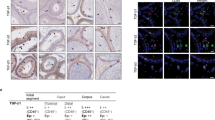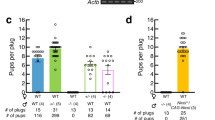Abstract
Although the role of the epididymis, a male accessory sex organ, in sperm maturation has been established for nearly four decades1, the maturation process itself has not been linked to a specific molecule of epididymal origin. Here we show that Bin1b, a rat epididymis-specific β-defensin with antimicrobial activity2, can bind to the sperm head in different regions of the epididymis with varied binding patterns. In addition, Bin1b-expressing cells, either of epididymal origin or from a Bin1b-transfected cell line, can induce progressive sperm motility in immotile immature sperm. This induction of motility is mediated by the Bin1b-induced uptake of Ca2+, a mechanism that has a less prominent role in maintaining motility in mature sperm. In vivo antisense experiments show that suppressed expression of Bin1b results in reduced binding of Bin1b to caput sperm and in considerable attenuation of sperm motility and progressive movement. Thus, β-defensin is important for the acquisition of sperm motility and the initiation of sperm maturation.
This is a preview of subscription content, access via your institution
Access options
Subscribe to this journal
Receive 12 print issues and online access
$209.00 per year
only $17.42 per issue
Buy this article
- Purchase on Springer Link
- Instant access to full article PDF
Prices may be subject to local taxes which are calculated during checkout




Similar content being viewed by others
References
Orgebin-Crist, M.C. Sperm maturation in rabbit epididymis. Nature 216, 816–818 (1967).
Li, P. et al. An antimicrobial peptide gene found in the male reproductive system of rats. Science 291, 1783–1785 (2001).
Bedford, J.M. Fertile life of rabbit spermatozoa in rat uterus. Nature 213, 1097–1099 (1967).
Fouchecourt, S., Metayer, S., Locatelli, A., Dacheux, F. & Dacheux, J.L. Stallion epididymal fluid proteome: qualitative and quantitative characterization; secretion and dynamic changes of major proteins. Biol. Reprod. 62, 1790–1803 (2000).
Dacheux, J.L., Gatti, J.L. & Dacheux, F. Contribution of epididymal secretory proteins for spermatozoa maturation. Microsc. Res. Tech. 61, 7–17 (2003).
von Horsten, H.H., Derr, P. & Kirchhoff, C. Novel antimicrobial peptide of human epididymal duct origin. Biol. Reprod. 67, 804–813 (2002).
Jeulin, C., Lewin, L.M., Chevrier, C. & Schoevaert-Brossault, D. Changes in flagellar movement of rat spermatozoa along the length of the epididymis: manual and computer-aided image analysis. Cell Motil. Cytoskeleton 35, 147–161 (1996).
Yeung, C.H., Oberlander, G. & Cooper, T.G. Characterization of the motility of maturing rat spermatozoa by computer-aided objective measurement. J. Reprod. Fertil. 96, 427–441 (1992).
Yeung, C.H. & Cooper, T.G. in Molecules to Clinical Practice (eds Robaire, B. & Hinton, B.) 417–434 (Plenum, New York, 2002).
Yeung, C.H., Oberlander, G. & Cooper, T.G. Maturation of hamster epididymal sperm motility and influence of the thiol status of hamster and rat spermatozoa on their motility patterns. Mol. Reprod. Dev. 38, 347–355 (1994).
Zasloff, M. Antimicrobial peptides of multicellular organisms. Nature 415, 389–395 (2002).
MacLeod, R.J. et al. Corticostatic peptides cause nifedipine-sensitive volume reduction in jejunal villus enterocytes. Proc. Natl Acad. Sci. USA 88, 552–556 (1991).
Bateman, A. et al. The isolation and characterization of a novel corticostatin/defensin-like peptide from the kidney. J. Biol. Chem. 271, 10654–10659 (1996).
Guraya, S.S. Cellular and molecular biology of capacitation and acrosome reaction in spermatozoa. Int. Rev. Cytol. 199, 1–64 (2000).
Breitbart, H. Intracellular calcium regulation in sperm capacitation and acrosomal reaction. Mol. Cell. Endocrinol. 187, 139–144 (2002).
Hoskins, D.D., Acott, T.S., Critchlow, L. & Vijayaraghavan, S. Studies on the roles of cyclic AMP and calcium in the development of bovine sperm motility. J. Submicrosc. Cytol. 15, 21–27 (1983).
Vijayaraghavan, S. & Hoskins, D.D. Low molecular weight factor in bovine caudal epididymal fluid that stimulates calcium uptake in caput spermatozoa. Gamete Res. 20, 343–352 (1988).
Vijayaraghavan, S., Bhattacharyya, A. & Hoskins, D.D. Calcium uptake by bovine epididymal spermatozoa is regulated by the redox state of the mitochondrial pyridine nucleotides. Biol. Reprod. 40, 744–751 (1989).
Serres, C. & Kann, M.L. Motility induction in hamster spermatozoa from caput epididymidis: effects of forward motility protein (FMP) and calmodulin inhibitor. Reprod. Nutr. Dev. 24, 81–94 (1984).
Peterson, R.N. & Freund, M. Relationship between motility and the transport and binding of divalent cations to the plasma membrane of human spermatozoa. Fertil. Steril. 27, 1301–1307 (1976).
Hammerstedt, R.H., Hay, S.R. & Amann, R.P. Modification of ram sperm membranes during epididymal transit. Biol. Reprod. 27, 745–754 (1982).
Yamaguchi, Y. et al. Identification of multiple novel epididymis-specific β-defensin isoforms in humans and mice. J. Immunol. 169, 2516–2523 (2002).
Com, E. et al. Expression of antimicrobial defensins in the male reproductive tract of rats, mice, and humans. Biol. Reprod. 68, 95–104 (2003).
Coronel, C.E., Winnica, D.E., Novella, M.L. & Lardy, H.A. Purification, structure, and characterization of caltrin proteins from seminal vesicle of the rat and mouse. J. Biol. Chem. 267, 20909–20915 (1992).
Zhang, L. et al. Contribution of human α-defensin 1, 2, and 3 to the anti-HIV-1 activity of CD8 antiviral factor. Science 298, 995–1000 (2002).
Hu, Y.X. et al. Get effective polyclonal antisera in one month. Cell Res. 12, 157–160 (2002).
Welch, J.E. et al. Human glyceraldehyde 3-phosphate dehydrogenase-2 gene is expressed specifically in spermatogenic cells. J. Androl. 21, 328–338 (2000).
Jiang, J.L. et al. The involvement of HAb18G/CD147 in regulation of store-operated calcium entry and metastasis of human hepatoma cells. J. Biol. Chem. 276, 46870–46877 (2001).
Chan, H.C., Ko, W.H., Zhao, W., Fu, W.O. & Wong, P.Y. Evidence for independent Cl− and HCO−3 secretion and involvement of an apical Na+-HCO−3 cotransporter in cultured rat epididymal epithelia. Exp. Physiol. 81, 515–524 (1996).
Grynkiewicz, G., Poenie, M. & Tsien, R.Y. A new generation of Ca2+ indicators with greatly improved fluorescence properties. J. Biol. Chem. 260, 3440–3450 (1985).
Acknowledgements
The work was supported by RGC of Hong Kong (CUHK4365/03M), the Strategic Program of The Chinese University of Hong Kong, the Distinguished Young Investigator Fund of the National Natural Science Foundation of China (to H.C.C.), the '973' Basic Research Funding Scheme of China (G 1999055901), the CAS Knowledge Creative Program (KSCX2-SW-201) and the Shanghai Development Foundation of Science and Technology (no. 03JC14080).
Author information
Authors and Affiliations
Corresponding author
Ethics declarations
Competing interests
The authors declare no competing financial interests.
Rights and permissions
About this article
Cite this article
Zhou, C., Zhang, YL., Xiao, L. et al. An epididymis-specific β-defensin is important for the initiation of sperm maturation. Nat Cell Biol 6, 458–464 (2004). https://doi.org/10.1038/ncb1127
Received:
Accepted:
Published:
Issue Date:
DOI: https://doi.org/10.1038/ncb1127
This article is cited by
-
Mechanisms and regulation of defensins in host defense
Signal Transduction and Targeted Therapy (2023)
-
Arl13b controls basal cell stemness properties and Hedgehog signaling in the mouse epididymis
Cellular and Molecular Life Sciences (2022)
-
Ablation of the sperm-associated antigen 11A (SPAG11A) protein by active immunization promotes epididymal oncogenesis in the rat
Cell and Tissue Research (2022)
-
Buffalo sperm surface proteome profiling reveals an intricate relationship between innate immunity and reproduction
BMC Genomics (2021)
-
Declined expressing mRNA of beta-defensin 108 from epididymis is associated with decreased sperm motility in blue fox (Vulpes lagopus)
BMC Veterinary Research (2021)



